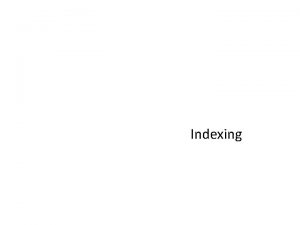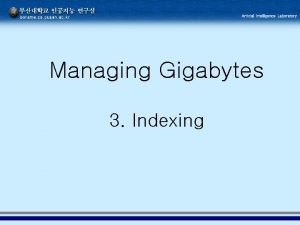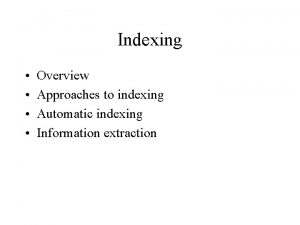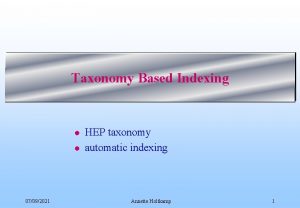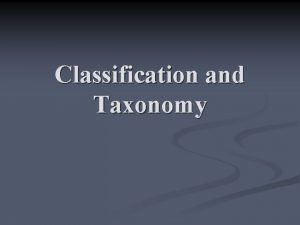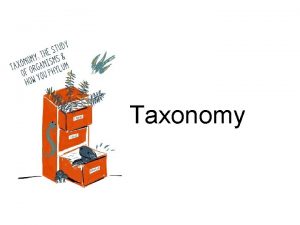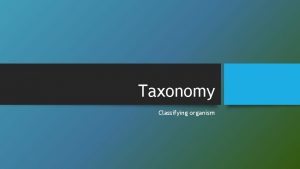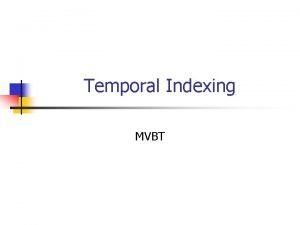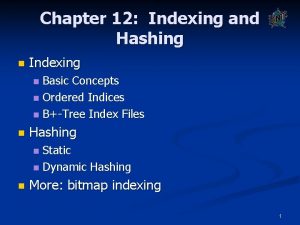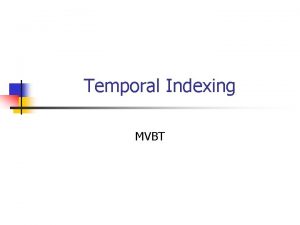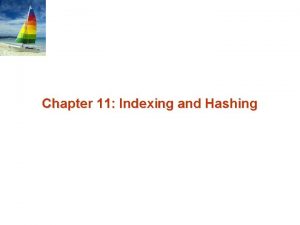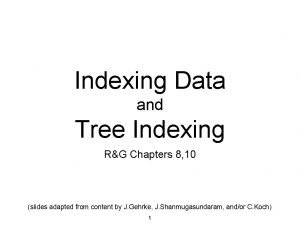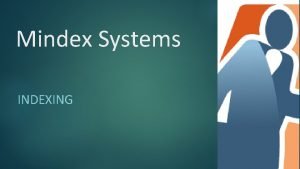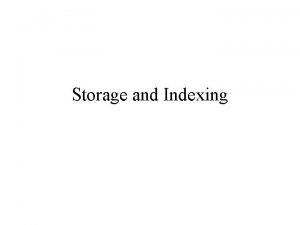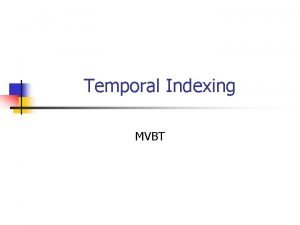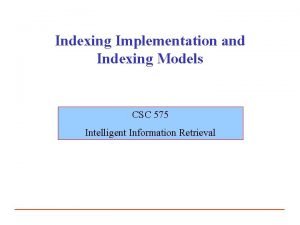Indexing with the AIRSInfo Line Taxonomy A Workshop














































- Slides: 46

Indexing with the AIRS/Info Line Taxonomy A Workshop for the 2001 AIRS Conference in Orlando Dick Manikowski, Detroit Public Library TIP Database & Subscriptions rmaniko@detroit. lib. mi. us

Workshop Objectives n n To review the Taxonomy’s structure and design To introduce basic principles and practices in indexing To help participants recognize some of the decisions that have to be made when using the Taxonomy To discuss Taxonomy maintenance and customization procedures Note—This workshop is heavily based on the model devised by Margaret Bruni for workshops offered at previous Conferences.

What Is a Taxonomy? taks-on´- -m 2: The systematic distinguishing, ordering and naming of type groups within a subject field: CLASSIFICATION (Webster’s Third New International Dictionary) Taxonomies include: telephone Yellow Pages I&R directory indexes aisle directories affixed to grocery shopping carts Dewey Decimal system for classifying library materials

What Is the AIRS/INFO LINE Taxonomy? A Taxonomy of Human Services: A Conceptual Framework with Standardized Terminology and Definitions for the Field, 3 rd ed. The Information and Referral Federation of Los Angeles and the Alliance of Information and Referral Systems, 1994. * *Has been periodically updated by supplements

Indexing 101: Principal Types of Indexes n n n Hierarchical (Classified) Index Alphabetical Index Keyword Index

Hierarchical (Classified) Index

Alphabetical Index

Keyword Index

The Bottom Line The agency has to decide whose convenience is more important—that of the resource management staff or that of the end-user.

The AIRS-INFO LINE Taxonomy is n n n a classified taxonomy (Hierarchical Display section) with an alphabetical index (Alphabetical Display section) and a keyword index (Permuted Display section) I&R software packages often permit access to the Taxonomy from all three points.

Taxonomy’s Hierarchical Display n n n Divides human and social services into ten Major Service Categories (with a separate eleventh Target Group Section), each branching into up to five Levels of Classification Each Major Service Category opens with an Outline for quick reference Each term has a unique identification number (Taxonomy Code) Each Taxonomy Term uses language from its field and has a precise and concise definition See Also References to other related terms are provided to help indexers

Hierarchical Relationships

Taxonomy Branch Level 1 Level 2 Level 3 Level 4 Level 5

Alphabetical Display n n n Taxonomy Codes Taxonomy Terms Term Definitions See Also References (which refer users to other preferred terms of possible interest) Use References and reciprocal Used For References (which refer users from non-preferred terms to preferred terms and vice versa) Emergency Generators (BM-175) Programs that pay for or provide portable generators which allow access to power when there are outages. See also Domestic Disaster Relief (JR -150. 150) Emergency Grocery Vouchers use Food Vouchers (BD-180. 225) Food Vouchers (BD-180. 25) used for Emergency Grocery Vouchers

Permuted (Keyword) Display n Alphabetically displays each word in each preferred term in context Formula/Baby Government Surplus Natural Occasional Emergency Ongoing Emergency Pet n Food Food Food Stamp Recipients Stamps Vouchers Distribution Restaurants Assistance Doesn’t include codes, definitions, Use References or See Also References

Types of Terms n n n Service terms describe specific services – Low Cost Meals – Long-Term Care Insurance Facility type terms describe what entities are (which often implies what they do) – Public Libraries – Senior Centers – Voluntary Heath Organizations Major program terms describe commonly known major programs – Medicare – WIC

Types of Terms (cont. ) n Target terms* describe groups at whom services and programs are targeted. Social Clubs/Events (a true service term) could be focused by combining it with: – Alcoholics – Pregnant Teens *Target terms are meant to be used to modify service terms and should never be used alone. Don’t confuse the concepts of targets and eligibility requirements.

Types of Terms (cont. ) n Modality terms* describe how services are delivered. Service term Discrimination Assistance (another true service term) could be modified by modality terms: – Legal Representation – Advocacy *Modality terms are meant to be used to modify service terms and should never be used alone.

Types of Terms (cont. ) n Orientation/Philosophy terms describe services which are provided in a manner which accommodates a particular philosophy – Service term Pregnancy Counseling (LJ-200. 650) is a true service term which is subdivided into two Orientation/Philosophy terms: • Pro-Choice Counseling (LJ-200. 650 -65) • Pro-Life Counseling (LJ-200. 650 -70)

Types of Terms

Types of Services (not Types of Service Terms) n Primary Services (entry point services which an individual can receive without already being affiliated with an agency) – Index primary services n n Secondary Services (individual must already be receiving a primary service to qualify for a secondary service) – Don’t index as Child Care Centers a community center which houses a Mutual Support Group for recovering alcoholic women and provides child care during their meetings. Only index the (latter) primary service. Indirect Services (services for which an agency makes referrals to other agencies) – Don’t index as Emergency Food Pantries an agency which makes referrals to providers but doesn’t actually distribute food. Index it as Information and Referral or as Specialized Information and Referral.

Types of Services (cont. ) n n Ancillary Services (services not important enough to index) – Don’t index as Speakers/Speakers Bureaus agencies who provide individuals who only speak about their agency’s activities—virtually every agency does that. Instead, reserve the term for agencies who can provide speakers on a variety of topics Phantom Services (services which are available so seldom that indexing them would be misleading) – If an agency purports to offer Temporary Financial Aid when their resources permit it but investigation reveals that this happens very rarely, think carefully before indexing this service for their entry in your database

Types of Services (cont. )

Indexing Principles n n Accuracy in Indexing – Choose the most specific term available* which fully describes what is being indexed *Availability of terms will be discussed later Don’t Double Index – Example—Indexing a service under terms: • Employment (ND) and • Employment Acquisition (ND-180) and • Job Search/Placement (ND-180. 360) The prohibition on double-indexing is based on the premise that the database/directory user should only have to look under a single term to find all the resources which offer a given service.

Indexing Principles (cont. ) n Consistency in Indexing – Once a term has been used to index one record, it should also be used for all other records to which it applies – Example—If you index Agency A as providing Job Search/Placement (ND-180), you can’t index Agency B as providing Employment Acquisition (ND-180. 360)

Understanding a Branch Within the Taxonomy Hierarchy 1 2 3 4 5

Consistent Indexing within a Branch 1 2 3 4 5 ** = Term authorized for use in indexing

Tracking Status of Terms in Your Implementation of the Taxonomy

Taxonomy’s Full Food (BD) Section B Basic Subsistence BD Food BD-260. 050 Food Production Agricultural Assistance BD-150 Communal Food BD-260. 050 -33 Irrigation Assistance BD-180 Emergency Food BD-260. 050 -35 Home Gardening Assistance BD-180. 100 Brown Bag Programs BD-180. 200 Food Pantries BD-180. 200 -20 Food Lines BD-180. 200 -62 Occasional Emergency Food BD-180. 200 -64 Ongoing Emergency Food BD-180. 225 Food Vouchers BD-180. 250 Government Surplus Food BD-180. 800 Sack Lunches/Dinners BD-180. 820 Specialty Food Providers BD-180. 820 -18 Drinking Water BD-180. 820 -20 Food Supplements BD-180. 820 -25 Formula/Baby Food BD-200 Food Banks BD-220 Food Gleaning Programs BD-240 Food Outlets BD-240. 200 Farm Trails BD-240. 225 Farmers Markets BD-240. 250 Food Co-ops BD-240. 500 Mini Markets BD-240. 900 U-Pick Programs BD-260. 150 Community Gardening BD-260. 450 Livestock Breeding/ Management BD-260. 700 Rent-A-Tree BD-500 Meals BD-500. 145 Child Care Food Programs BD-500. 150 Congregate Meals BD-500. 350 Home Delivered Meals BD-500. 450 Low-Cost Meals BD-500. 500 Meal Vouchers BD-500. 510 Milk Programs BD-500. 520 Mobile Canteens BD-500. 800 School Breakfasts BD-500. 820 School Lunches BD-500. 830 Soup Kitchens BD-500. 850 Summer Food Service Programs

Customized Food Sections No agency would (or should) use all of the Food terms to index its file. Instead, each agency would choose a particular subset of terms Customized For a Comprehensive I&R: Customized For a Senior I&R: BD-180. 200 Food Pantries BD-180. 100 BD-180. 225 Food Vouchers Brown Bag Programs BD-180. 250 Government Surplus Food BD-180. 820. 20 Food Supplements BD-240. 500 Mini Markets BD-200 Food Banks BD-500. 150 Congregate Meals BD-260. 050 Agricultural Assistance BD-500. 350 Home Delivered Meals BD-260. 150 Congregate Meals BD-500. 450 Low-Cost Meals BD-260. 350 Home Delivered Meals Customized For a Disability I&R: Soup Kitchens BD-180. 820 -20 Food Supplements BD-500. 350 Home Delivered Meals BD-260. 830

Factors to Consider in Determining the Level at Which to Index a Subject Area n n n How specific are service requests in that subject area? What is the skill level of staff? How specifically can your afford to index? How volatile is the information you are indexing? What are your agency’s priorities? Remember—Depth of indexing can vary between individual subject areas within a database. All that matters is the absolute consistency within any single subject area.

Specific Indexing Steps ¶Identify the primary service concept ·Is a facility type appropriate to describe it? ¸Identify the most appropriate term to characterize that service concept a Try to use the Classified Index directly b Use the Outlines for orientation c Use Alphabetical and Permuted Indexes as access points to the Classified Index ¹Read the definition to verify that the term is right

Specific Indexing Steps (cont. ) ºReview the hierarchy to confirm the level selected » Look at the See Also references listed for the term. Should any of them be used to index the concept? ¼Is a modality needed to clarify the manner in which the service is delivered? ½Is a target group needed to clarify the group at which the program is aimed? ¾If the capability exists in your software, do any of the terms need to be linked?

Indexing Exercise #1 CHRISTIAN GUIDANCE CENTER 3684 Trumbull Ave. , Detroit, MI 48208 313/832 -1470 Purpose: (1979) A residential program designed to re-integrate recovering substance abusers into the community. Program is aimed at ex-offenders, but not limited to this group. Services: 1) Individual counseling 2) Group therapy 3) Adult basic education classes 4) GED classes 5) Recreational activities. Eligibility: Men age 18 and over. Serves the tri-county area. What are the primary service(s)?

Christian Guidance Center n n n LX Substance Abuse LX-185 Drug Testing LX-330 Inpatient Substance Abuse Programs LX-500 Maintenance Treatment LX-650 Outpatient Substance Abuse Programs LX-700 Residential Substance Abuse Programs LX-800 Smoking Cessation LX-825 Substance Abuse Education/Prevention LX-850 Transitional Substance Abuse Services LX-850. 050 Alcoholism-Related Transitional Services LX-850. 170 Drug-Related Transitional Services

CHRISTIAN GUIDANCE CENTER 3684 Trumbull Ave. , Detroit, MI 48208 313/832 -1470 Purpose: (1979) A residential program designed to re-integrate recovering substance abusers into the community. Program is aimed at ex-offenders, but not limited to this group. Services: 1) Individual counseling 2) Group therapy 3) Adult basic education classes 4) GED classes 5) Recreational activities. Eligibility: Men age 18 and over. Serves the tri-county area. Are there any appropriate target(s)? Check the Y section outline (starting on p. 269)

Target Population YP Offenders YP-100 Batterers YP-100. 180 Elder Abusers YP-100. 650 Parent Abusers YP-100. 800 Spouse/Partner Abusers YP-140 Child Abusers YP-140. 330 Incest Perpetrators YP-160 Defendants YP-180 Detainees YP-200 Ex-Offenders YP-250 Gang Members

Indexing Exercise #2 (see handout) American Diabetes Association Working from the photocopy of the brochure for the American Diabetes Association’s Michigan Chapter, make a list of all the services referred to. Don’t worry about finding the correct Taxonomy terms for each service yet!

American Diabetes Association Full Inventory of Services n n n n n Research Support Groups Patient Education Professional Education Public Education Literature Hotline Camperships n n n n n Youth Services Fund Raising Volunteers Magazine Newsletter Workshops/Meetings Films/Videos Cookbook Recreational Activities Special Library

Indexing Issues for American Diabetes Association Special Libraries Film Collections/Video Tape Collections Professional Continuing Education Camperships Research Recreational Activities Voluntary Activities Ancillary Service Secondary Service Indirect Service Not Enough Information Policy Decision

Indexing Options for American Diabetes Association n Option 1 – Voluntary Health Organizations n Option 2 – Voluntary Health Organizations – Health Education – Mutual Support Groups – Camps n Option 3 – Voluntary Health Organizations – Disease/Disability Information – Mutual Support Groups – Therapeutic Camps n Option 4 – Voluntary Health Organizations – Disease/Disability Information x Newsletters x Printed Materials x Workshops x Medical Information Lines – Mutual Support Groups x Health Problems Counseling – Therapeutic Camps

Converting Your Database to the Taxonomy ¶ Convert one subject area at a time. · Locate the section(s) of the Taxonomy that cover(s) the types of resources to be re-indexed. ¸ Determine which terms in the Taxonomy can be eliminated for use in your file. Consider: n What type of resources are available in the community? n What are your inclusion criteria for your file? n What types of resources does your file currently contain?

Converting Your Database to the Taxonomy (cont. ) ¹ Determine the level of detail which is appropriate for the remaining Taxonomy terms. n How specific are the service requests you receive from your clients? n What is the skill level of your staff? n How specifically can your staff afford to index? n How volatile is the information your file contains? n What are your priorities? º Look for legitimate shortcuts. » Keep track of available, unavailable, and used terms (see attached suggested conventions)

Questions About Indexing with the Taxonomy? n n n You can e-mail me, but I can’t guarantee that I’ll have the time or expertise to help you A better option is to join the AIRS Networker and post your questions there. (For subscription information, click on: http: //www. airs. org/other. htm) To suggest new indexing terms, write to Georgia Sales (gsales 4215@aol. com)

Keeping the Taxonomy Up-to-Date in Your Database n Consult Georgia Sales’ article from v. 20 (1998) of Information and Referral: The AIRS Journal (also available on the AIRS Web site; www. airs. org/library)

Workshop Objectives n n To review the Taxonomy’s structure and design To introduce basic principles and practices in indexing To help participants recognize some of the decisions that have to be made when using the Taxonomy To discuss Taxonomy maintenance and customization procedures Note—Please take the time to fill out your workshop evaluation forms. The information you supply will be helpful both to me and to planners of future conferences.
 Popsi indexing system
Popsi indexing system Manual indexing vs automatic indexing
Manual indexing vs automatic indexing The new taxonomy kendall and marzano taxonomy
The new taxonomy kendall and marzano taxonomy Classification of surveying
Classification of surveying Hát kết hợp bộ gõ cơ thể
Hát kết hợp bộ gõ cơ thể Ng-html
Ng-html Bổ thể
Bổ thể Tỉ lệ cơ thể trẻ em
Tỉ lệ cơ thể trẻ em Chó sói
Chó sói Glasgow thang điểm
Glasgow thang điểm Bài hát chúa yêu trần thế alleluia
Bài hát chúa yêu trần thế alleluia Các môn thể thao bắt đầu bằng tiếng bóng
Các môn thể thao bắt đầu bằng tiếng bóng Thế nào là hệ số cao nhất
Thế nào là hệ số cao nhất Các châu lục và đại dương trên thế giới
Các châu lục và đại dương trên thế giới Cong thức tính động năng
Cong thức tính động năng Trời xanh đây là của chúng ta thể thơ
Trời xanh đây là của chúng ta thể thơ Mật thư anh em như thể tay chân
Mật thư anh em như thể tay chân 101012 bằng
101012 bằng Phản ứng thế ankan
Phản ứng thế ankan Các châu lục và đại dương trên thế giới
Các châu lục và đại dương trên thế giới Thể thơ truyền thống
Thể thơ truyền thống Quá trình desamine hóa có thể tạo ra
Quá trình desamine hóa có thể tạo ra Một số thể thơ truyền thống
Một số thể thơ truyền thống Cái miệng bé xinh thế chỉ nói điều hay thôi
Cái miệng bé xinh thế chỉ nói điều hay thôi Vẽ hình chiếu vuông góc của vật thể sau
Vẽ hình chiếu vuông góc của vật thể sau Thế nào là sự mỏi cơ
Thế nào là sự mỏi cơ đặc điểm cơ thể của người tối cổ
đặc điểm cơ thể của người tối cổ V cc
V cc Vẽ hình chiếu đứng bằng cạnh của vật thể
Vẽ hình chiếu đứng bằng cạnh của vật thể Phối cảnh
Phối cảnh Thẻ vin
Thẻ vin đại từ thay thế
đại từ thay thế điện thế nghỉ
điện thế nghỉ Tư thế ngồi viết
Tư thế ngồi viết Diễn thế sinh thái là
Diễn thế sinh thái là Các loại đột biến cấu trúc nhiễm sắc thể
Các loại đột biến cấu trúc nhiễm sắc thể Bảng số nguyên tố
Bảng số nguyên tố Tư thế ngồi viết
Tư thế ngồi viết Lời thề hippocrates
Lời thề hippocrates Thiếu nhi thế giới liên hoan
Thiếu nhi thế giới liên hoan ưu thế lai là gì
ưu thế lai là gì Hổ đẻ mỗi lứa mấy con
Hổ đẻ mỗi lứa mấy con Khi nào hổ mẹ dạy hổ con săn mồi
Khi nào hổ mẹ dạy hổ con săn mồi Sơ đồ cơ thể người
Sơ đồ cơ thể người Từ ngữ thể hiện lòng nhân hậu
Từ ngữ thể hiện lòng nhân hậu Thế nào là mạng điện lắp đặt kiểu nổi
Thế nào là mạng điện lắp đặt kiểu nổi Dividing head calculations chart
Dividing head calculations chart















































